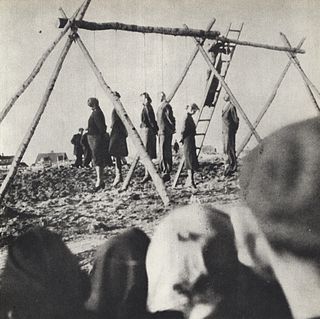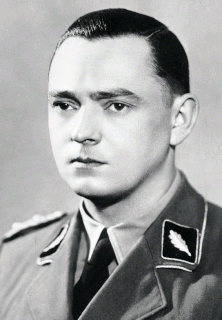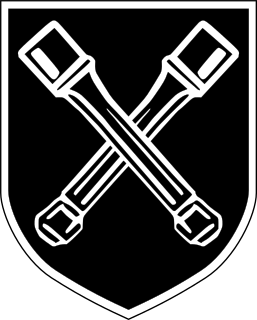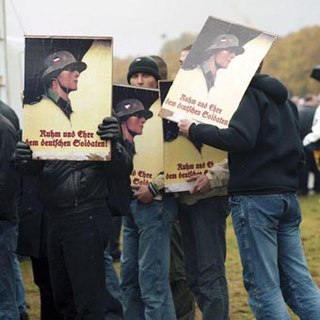 W
WNazi crime or Hitlerite crime is a legal concept used in some legal systems.
 W
WThe "Kugel-Erlass" also known as "Aktion Kugel" was a secret decree (Geheimbefehl), issued by Nazi Germany on 2 March 1944. The decree stated that escaped Allied prisoners of war, especially officers and senior non-commissioned officers, should be handed over to the Sicherheitsdienst (SD) who should execute them, "im Rahmen der Aktion Kugel", in Mauthausen-Gusen concentration camp.
 W
WThe Ardeatine massacre, or Fosse Ardeatine massacre, was a mass killing carried out in Rome on 24 March 1944 by German occupation troops during the Second World War as a reprisal for the Via Rasella attack conducted on the previous day in central Rome against the SS Police Regiment Bozen.
 W
WThe Battle of Dražgoše was a Second World War battle between the Slovene Partisans and Nazi Germany armed forces, which took place between January 9 and January 11, 1942, in the village of Dražgoše in German-annexed Slovenia. This battle was the first direct confrontation between the two. It ended with brutal reprisals of German forces against the villagers and the destruction of the village.
 W
WHorst Böhme was a German SS functionary during the Nazi era. He served in the SD, the intelligence service of the SS, and was a leading perpetrator of the Holocaust.
 W
WThe Bunker Tragedy or the Bunkerdrama was an atrocity committed by the staff at the Herzogenbusch concentration camp in the Netherlands, in January 1944 during World War II.
 W
WIn World War II, Nazi Germany established brothels in the concentration camps (Lagerbordell) to create an incentive for prisoners to collaborate, although these institutions were used mostly by Kapos, "prisoner functionaries" and the criminal element, because regular inmates, penniless and emaciated, were usually too debilitated and wary of exposure to Schutzstaffel (SS) schemes. In the end, the camp brothels did not produce any noticeable increase in the prisoners' work productivity levels, but instead, created a market for coupons among the camp VIPs.
 W
WThe Commissar Order was an order issued by the German High Command (OKW) on 6 June 1941 before Operation Barbarossa. Its official name was Guidelines for the Treatment of Political Commissars. It instructed the Wehrmacht that any Soviet political commissar identified among captured troops be summarily executed as a purported enforcer of the "Judeo-Bolshevism" ideology in military forces. It is one of a series of criminal orders issued by the leadership.
 W
WThe Concentration Camps Inspectorate (CCI) or in German, IKL was the central SS administrative and managerial authority for the concentration camps of the Third Reich. Created by Theodor Eicke, it was originally known as the "General Inspection of the Enhanced SS-Totenkopfstandarten", after Eicke's position in the SS. It was later integrated into the SS Main Economic and Administrative Office as "Amt D".
 W
WDeath marches refer to the forcible movement of prisoners by Nazi Germany toward the end of World War II and the Holocaust. The marches took place mostly between the summer/autumn of 1944 and May 1945, when hundreds of thousands of prisoners, mostly Jews, from German concentration camps near the eastern front were moved to camps inside Germany away from Allied forces. The purpose of the marches was to allow the Germans to use the prisoners as slave labour, to remove evidence of crimes against humanity, and to retain control of the prisoners in case they could be used to bargain with the Allies.
 W
WThe Dirlewanger Brigade, also known as the SS-Sturmbrigade Dirlewanger (1944), or the 36th Waffen Grenadier Division of the SS, or Black Hunters, was a unit of the Waffen-SS during World War II. The unit, named after its commander Oskar Dirlewanger, consisted of convicted criminals who were not expected by Nazi Germany to survive their service with the unit. Originally formed in 1940 and first deployed for counter-insurgency duties against the Polish resistance movement, the brigade saw service in the Bandenbekämpfung ("bandit-fighting") actions in German-occupied Eastern Europe.
 W
WThe Disciplinary and Penal Code was first written for Dachau concentration camp and became the uniform code at all SS concentration camps in the Third Reich on January 1, 1934. Also known as the Strafkatalog, it detailed the regulations for prisoners. SS guards were instructed to report violations of the code to the commandant's office. The Concentration Camps Inspectorate was responsible for execution of the resulting punishment, which was carried out without verification of the allegations or any possibility of vindication.
 W
WThe use of slave and forced labour in Nazi Germany and throughout German-occupied Europe during World War II took place on an unprecedented scale. It was a vital part of the German economic exploitation of conquered territories. It also contributed to the mass extermination of populations in occupied Europe. The Germans abducted approximately 12 million people from almost twenty European countries; about two thirds came from Central Europe and Eastern Europe. Many workers died as a result of their living conditions – extreme mistreatment, severe malnutrition, and worse tortures were the main causes of death. Many more became civilian casualties from enemy (Allied) bombing and shelling of their workplaces throughout the war. At its peak the forced labourers comprised 20% of the German work force. Counting deaths and turnover, about 15 million men and women were forced labourers at one point during the war.
 W
WFrankolovo crime is one of the worst Nazi war crimes in the territory of present Slovenia during World War II. On February 12, 1945 members of Wehrmacht killed one hundred Slovene civilians at Graben (»ditch«) in Stranice near Frankolovo.
 W
WGerman retribution against Poles who helped Jews were repressive measures taken by the German occupation authorities against non-Jewish Polish citizens who helped Jews persecuted by Nazi Germany during the Holocaust in Poland, 1939 to 1945.
 W
WThe Holocaust in the Independent State of Croatia is a term which is primarily used in reference to the genocide of Jews, but sometimes, it is also used in reference to the genocide of Serbs and Romani (Porajmos), within the Independent State of Croatia, a fascist puppet state which existed during World War II, was led by the Ustaše regime, and ruled an occupied area of Yugoslavia which included most of the territory of modern-day Croatia, the whole of modern-day Bosnia and Herzegovina and the eastern part of Syrmia (Serbia). Of the 39,000 Jews who lived in the NDH in 1941, the United States Holocaust Memorial Museum states that more than 30,000 were killed. Of these, 6,200 were shipped to Nazi Germany and the rest of them were killed in the ISC, the vast majority were killed in Ustaše-run concentration camps, such as Jasenovac. The Ustaše were the only quisling forces in Europe who operated their own extermination camps for the purpose of killing Jews and members of other ethnic groups.
 W
WThe Holocaust, also known as the Shoah, was the World War II genocide of the European Jews. Between 1941 and 1945, across German-occupied Europe, Nazi Germany and its collaborators systematically murdered some six million Jews, around two-thirds of Europe's Jewish population. The murders were carried out in pogroms and mass shootings; by a policy of extermination through work in concentration camps; and in gas chambers and gas vans in German extermination camps, chiefly Auschwitz, Bełżec, Chełmno, Majdanek, Sobibór, and Treblinka in occupied Poland.
 W
WDuring World War II, 20,000–50,000 mostly Polish and Soviet children were abducted from their homes and forcibly moved to Nazi Germany for the purpose of Germanization, or indoctrination into becoming German. According to Dirk Moses' estimate, 20,000 children were abducted for such purposes from Poland, 20,000 from the Soviet Union, and 10,000 from western and southeastern Europe. The aim of the project was to acquire and "Germanize" children with purportedly Aryan-Nordic traits, who were considered by Nazi officials to be descendants of German settlers that had emigrated to Poland. Those labeled "racially valuable" were forcibly Germanized in centres and then sent to German families and SS Home Schools.
 W
WThe Malmedy massacre was a war crime committed by members of Kampfgruppe Peiper, a German Waffen-SS unit led by Joachim Peiper, at Baugnez crossroads near Malmedy, Belgium, on 17 December 1944, during the Battle of the Bulge. Eighty-four American prisoners of war were massacred by their German captors. The prisoners were assembled in a field and shot with machine guns; those still alive were killed by close-range shots to the head.
 W
W"The March" refers to a series of forced marches during the final stages of the Second World War in Europe. From a total of 257,000 western Allied prisoners of war held in German military prison camps, over 80,000 POWs were forced to march westward across Poland, Czechoslovakia, and Germany in extreme winter conditions, over about four months between January and April 1945. This series of events has been called various names: "The Great March West", "The Long March", "The Long Walk", "The Long Trek", "The Black March", "The Bread March", and "Death March Across Germany", but most survivors just called it "The March".
 W
WThe Vienna City Memorial is a memorial located at the Vienna Central Cemetery and dedicated to "the victims for a free Austria 1934-1945". It was donated by the City of Vienna, designed by Fritz Cremer, Wilhelm Schütte and Margarete Schütte-Lihotzky and handed over to the public by Mayor Theodor Körner on 1 November 1948.
 W
WThe Mühlviertler Hasenjagd was a war crime in which 500 Soviet officers, who had revolted and escaped from the Mühlviertel subcamp of Mauthausen-Gusen concentration camp on 2 February 1945, were hunted down. Local civilians, soldiers and local Nazi organizations hunted down the escapees for three weeks, executing most of them. Of the original 500 prisoners who took part in the escape attempt, eleven succeeded in remaining free until the end of the war. The mass escape was unique in Mauthausen's history.
 W
WThe myth of the clean Wehrmacht is the fictitious notion that the regular German armed forces were not involved in the Holocaust or other war crimes during World War II. The myth denies the culpability of the German military command in the planning and preparation of war crimes. Even where the perpetration of war crimes and the waging of a war of extermination, particularly in the Soviet Union — where the Nazis viewed the population as "subhumans" ruled by "Jewish Bolshevik" conspirators—has been acknowledged, they are ascribed to the "Party soldiers", the Schutzstaffel (SS), and not the regular German military.
 W
WNacht und Nebel, meaning Night and Fog, was a directive issued by Adolf Hitler on 7 December 1941 targeting political activists and resistance "helpers" in World War II to be disappeared, imprisoned, or killed, while the family and the population remained uncertain as to the fate or whereabouts of the Nazi state's alleged offender. Victims who disappeared in these clandestine actions were never heard from again.
 W
WNazi plunder was stealing of art and other items as a result of the organized looting of European countries during the time of the Third Reich by agents acting on behalf of the ruling Nazi Party of Germany. Plundering occurred from 1933 until the end of World War II, particularly by military units known as the Kunstschutz, although most plunder was acquired during the war. In addition to gold, silver and currency, cultural items of great significance were stolen, including paintings, ceramics, books and religious treasures. Although most of these items were recovered by agents of the Monuments, Fine Arts, and Archives program, on behalf of the Allies immediately following the war, many are still missing. There is an international effort underway to identify Nazi plunder that still remains unaccounted for, with the aim of ultimately returning the items to the rightful owners, their families or their respective countries.
 W
WOstarbeiter was a Nazi German designation for foreign slave workers gathered from occupied Central and Eastern Europe to perform forced labor in Germany during World War II. The Germans started deporting civilians at the beginning of the war and began doing so at unprecedented levels following Operation Barbarossa in 1941. They apprehended Ostarbeiter from the newly-formed German districts of Reichskommissariat Ukraine, District of Galicia, and Reichskommissariat Ostland. These areas comprised German-occupied Poland and the conquered territories of the Soviet Union. According to Pavel Polian, over 50% of Ostarbeiters were formerly Soviet subjects originating from the territory of modern-day Ukraine, followed by Polish women workers. Eastern workers included ethnic Ukrainians, Poles, Belarusians, Russians, Tatars, and others. Estimates of the number of Ostarbeiter range between 3 million and 5.5 million.
 W
WThe Postenpflicht was a general order issued to SS-Totenkopfverbände guards in Nazi concentration camps to summarily execute insubordinate prisoners. The order required guards to shoot prisoners who engaged in resistance or escape attempts, without warning; failing to do so would result in dismissal or arrest. The Postenpflicht was originally issued on October 1, 1933, for guards at Dachau concentration camp, but was later extended to other concentration camps.
 W
WThe Putten raid was a civilian raid conducted by Nazi Germany in occupied Netherlands during the Second World War. On 1 October 1944, a total of 602 men – almost the entire male population of the village – were taken from Putten, in the central Netherlands, and deported to various concentration camps inside Germany. Only 48 returned at the end of the war. The raid was carried out as a reprisal for a Dutch resistance attack on a vehicle carrying personnel from the Wehrmacht.
 W
WThe Severity Order or Reichenau Order was the name given to an order promulgated within the German Sixth Army on the Eastern Front during World War II by Generalfeldmarschall Walther von Reichenau on 10 October 1941.
 W
WSonderaktion 1005, also called Aktion 1005, or Enterdungsaktion, began in May 1942 during World War II to hide any evidence that people had been murdered by Nazi Germany in German-occupied Poland and Soviet Union. The project, which was conducted in secrecy from 1942 to 1944, focused on concealing evidence of mass murder at the Operation Reinhard killing centres, as well as at other sites. Prisoner groups used to exhume mass graves and burn the bodies were officially called Leichenkommandos and were part of Sonderkommando 1005; inmates were often put in chains to prevent them from escaping.
 W
W"The Spoils of War—World War II and Its Aftermath: The Loss, Reappearance, and Recovery of Cultural Property" was an international symposium held in New York City in 1995 to discuss the artworks, cultural property, and historic sites damaged, lost, and plundered as a result of World War II. The three-day event was sponsored by the Bard Graduate Center for Studies in the Decorative Arts to commemorate the 50th anniversary of the end of the war. The conference was organized by Elizabeth Simpson, an archaeologist and professor at the Bard Graduate Center.
 W
WTrandumskogen is a forest located in Ullensaker, Akershus county, Norway. It was the site of one of the first discoveries in May 1945 of German mass graves in Norway. The German executioner Oskar Hans was the officer in command of the unit performing the executions.
 W
WThe Vinkt massacre was a war crime committed by German soldiers in the villages of Vinkt and Meighem in East Flanders on 26–28 May 1940 during the Battle of the Lys. Between 86 and 140 civilians were deliberately killed by Wehrmacht troops from the 337th Infantry Regiment of the 208th Infantry Division, supposedly in retaliation for the Belgian Army's resistance in the village.
 W
WDuring World War II, the Germans' combined armed forces committed systematic war crimes, including massacres, mass rape, looting, the exploitation of forced labor, the murder of three million Soviet prisoners of war, and participated in the extermination of Jews. While the Nazi Party's own SS forces of Nazi Germany was the organization most responsible for the genocidal killing of the Holocaust, the regular armed forces of the Wehrmacht committed many war crimes of their own, particularly on the Eastern Front in the war against the Soviet Union. According to a study by Alex J. Kay and David Stahel, the majority of the Wehrmacht soldiers deployed to the Soviet Union participated in war crimes.
 W
WYantarny, previously known in German as Palmnicken (help·info), is an urban locality in Kaliningrad Oblast, Russia, located on the Sambian Peninsula, about 40 kilometers (25 mi) from Kaliningrad, the administrative center of the oblast. Population: 5,524 (2010 Census); 5,455 (2002 Census); 4,948 (1989 Census).